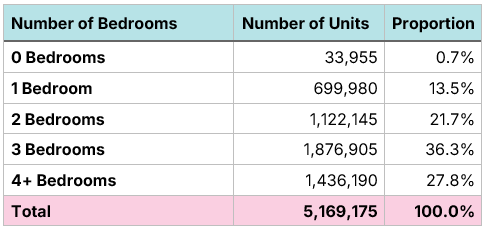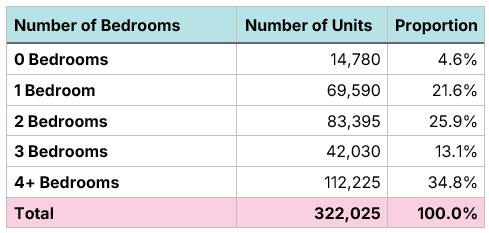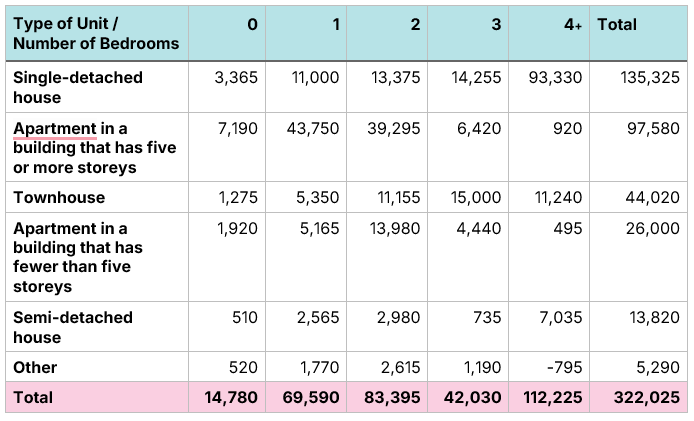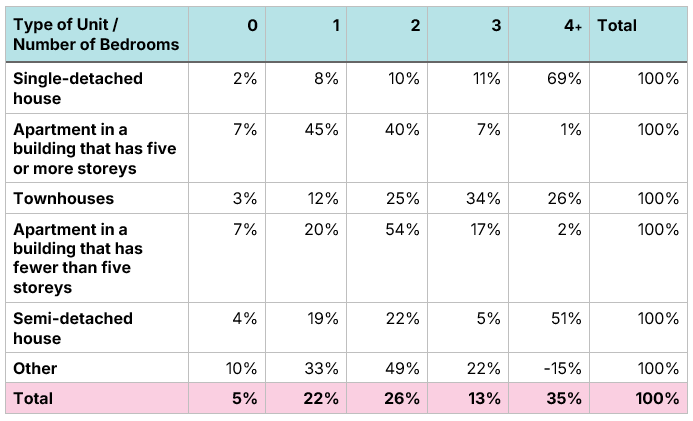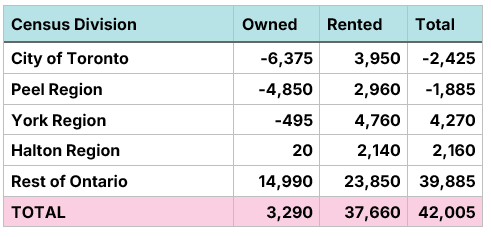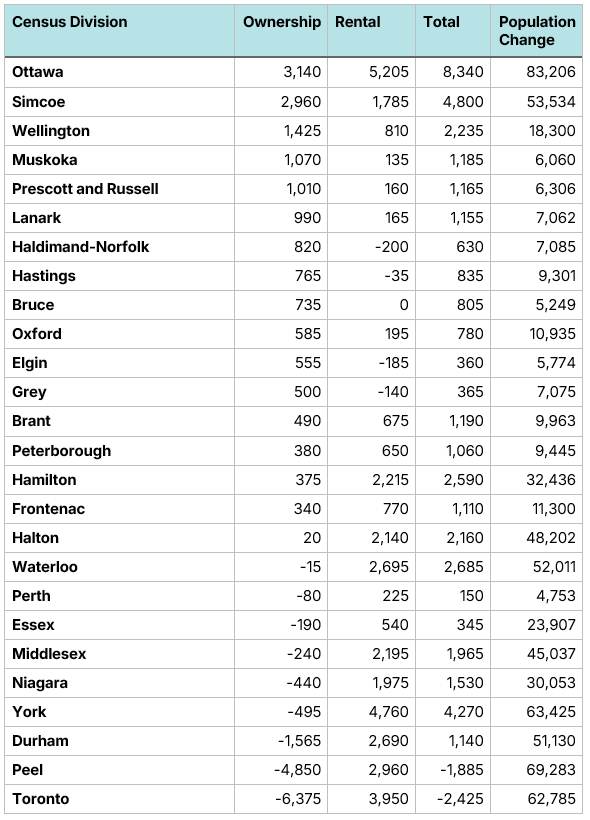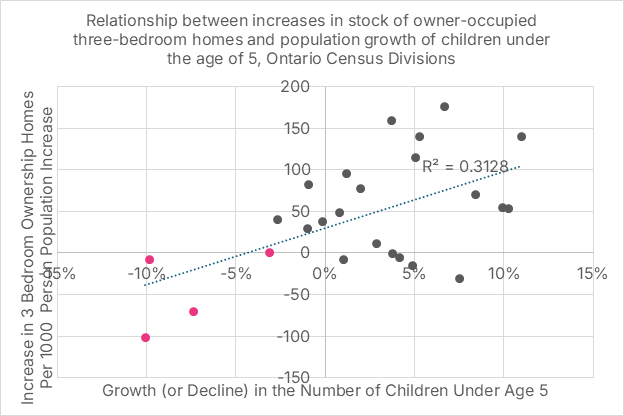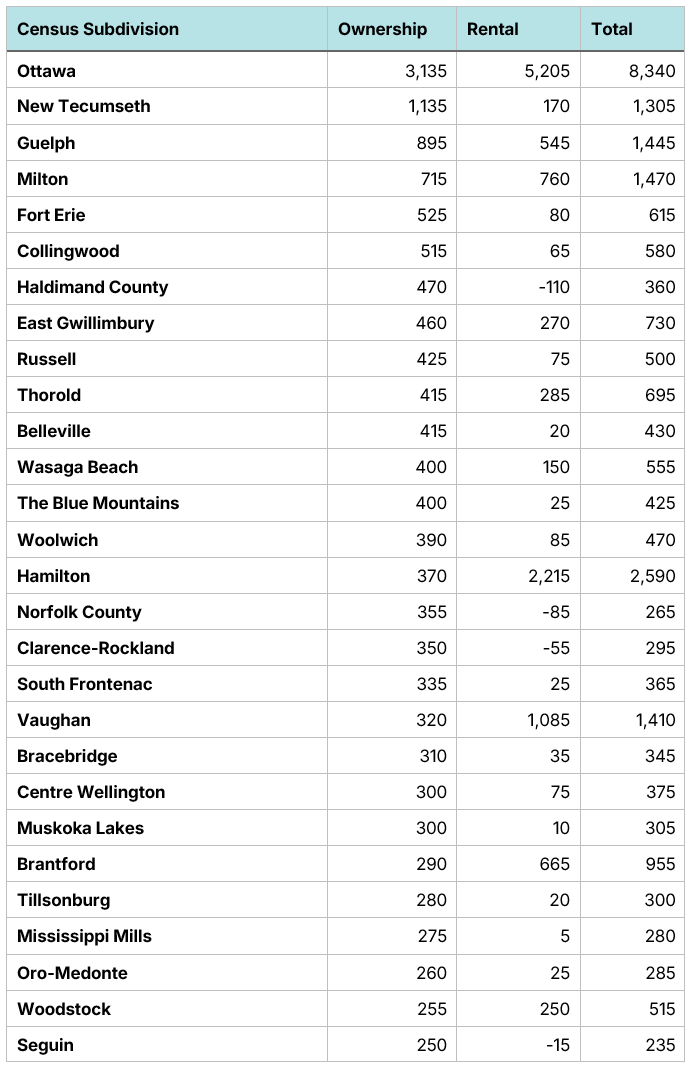The Baby Bust and the Death of the Three-Bedroom Ownership Home
The two are not unrelated
Highlights
Three-bedroom homes are the most common form of housing in Ontario, and have historically been quite popular with young, middle-class couples with children.
Despite their popularity, very few three-bedroom homes are being built in the GTA for various regulatory, tax, and economic reasons. In fact, large parts of the GTA are, on net, losing three-bedroom stock due to demolitions.
For middle-class families who wish to own a three-bedroom home in the GTA, the situation has become even more dire, as the stock of owner-occupied three-bedroom homes has fallen, due to Ontario’s rapid increase in the number of renters, lack of growth in the purpose-built rental stock, and three-bedroom homes becoming an increasingly rare asset, driving hoarding and speculation.
This lack of three-bedroom homes has led to a significant decline in the population of children under the age of five in the GTA, as families have chosen to relocate to other communities or are opting for smaller families in response to housing scarcity.
A variety of reforms are needed, from land use to development charges to building code, to help restore the dream of owning a three-bedroom home for middle-class Ontario families.
No province for young kids
The intersection of housing shortages and family planning decisions has become a topic of conversation during the federal election campaign. The team at the Missing Middle has no interest in commenting on specific remarks made by any politician or member of the media. However, we are always looking to have a data-driven discussion about housing. We believe there is an interesting conversation to be had about the choices families are making and the decline of the three-bedroom ownership home in the Greater Toronto Area (GTA).
The population of young children is rising in most of Ontario, even if falling overall
Between the 2016 Census and the 2021 Census, Ontario’s population of children under the age of five decreased by nearly 14,000, representing a 2% decline. Despite this, in most of Ontario’s 49 census divisions, the population of children under the age of five increased. There were, however, four Census Divisions, all in the GTA, where the population of children under the age of five decreased by over 700.
Figure 1. Census population of children under the age of five
In absolute terms, many young children still reside in the GTA. However, a 9% drop over five years in both the City of Toronto and York Region, while the rest of the province experiences increases, should be of grave concern to policymakers, as it suggests that young families are being pushed out of these markets.
There are several reasons why the GTA is experiencing a decline in the number of children, while the rest of the province is not. One important factor is the availability of three-bedroom homes for ownership, which is influencing both location choice and family size. Young, middle-class families have typically looked to raise a family in a three-bedroom home, but these have become increasingly scarce in Ontario, particularly in the GTA.
Ontario builds very few three-bedroom homes
Historically, three-bedroom homes have been the most common form of housing in Ontario. In 2016, over 36% of all occupied homes had three bedrooms, with four-bedroom homes being the next most common. By “homes,” we mean all forms of housing, ranging from single-detached dwellings to apartment units to mobile homes, and both ownership and rental.
Figure 2. 2016 occupied housing stock by number of bedrooms, Ontario
Between the 2016 Census and the 2021 Census, Ontario’s occupied housing stock increased by 322,000 units. Over that time, three-bedroom homes saw the second-smallest increase in number of units, ahead of only zero-bedroom units (studio suites).
Figure 3. Change in occupied housing stock by number of bedrooms from 2016 to 2021, Ontario
We can further analyze this data by examining the increase in the overall housing stock by unit type.
Figure 4. Change in occupied housing stock by number of bedrooms and unit type from 2016 to 2021, Ontario
In absolute terms, the stock of occupied 3-bedroom homes increased by 42,000, with townhomes accounting for 15,000 of that increase, just slightly ahead of single-detached homes. It is helpful to examine this data in terms of the proportion of homes by bedroom type. For example, of the 135,325 unit increase in occupied single-detached homes, 14,255, or 11%, were three-bedroom units.
Figure 5. Proportion of the number of bedrooms for each unit type, relative to the increase in the number of occupied units from 2016 to 2021, Ontario
Townhouses are the only unit type where the proportion of new three-bedroom units (34%) is in line with the historic overall average for Ontario (36%). Single-detached and semi-detached homes are getting larger (historically, 43% and 26% of these were four-bedroom units; new construction is 69% and 51% respectively), and apartments are getting smaller. Because there has been a substantial shift over the last decade from building ground-oriented homes to building apartments, the median new home has fewer bedrooms and is smaller than homes built in the past.
Future pieces will examine why the proportion of newly constructed three-bedroom homes is so low. For single-detached and semi-detached homes, much of the answer revolves around development charges and the cost and availability of land. It simply does not make economic sense to build a small single-detached home when the combined cost of land and municipal fees approaches half a million dollars before you even break ground. For smaller apartments, a combination of building code, zoning rules, and development charges often renders three-bedroom units impractical; Environmental Defense’s Mid-Rise Manual is a fantastic primer on the issue.
The GTA is losing three-bedroom ownership homes through conversion to rentals and demolitions
At the Missing Middle, we believe that middle-class families should have the option to either buy or rent a home. Our North Star, which guides our work, is as follows:
Every middle-class individual or family in Canada should have a high-quality of life and access to both market-rate rental and market-rate ownership housing options that are affordable, adequate, suitable, resilient, and climate-friendly in every city in Canada.
Middle-class families in the GTA have been denied the option of buying a three-bedroom home. Despite substantial population growth, the number of owner-occupied homes fell in the City of Toronto, Peel Region, and York Region and was flat in Halton. This was partly due to formerly owner-occupied homes shifting to the rental market. Increases in immigration targets and an international student boom caused a substantial increase in net international migration to Ontario (750,000 persons from July 1, 2016, to June 30, 2021, compared to 485,000 the year before). As we noted in an earlier piece, these conversions were a natural market reaction to a substantial increase in the population of renters. Both newcomers and existing residents have a human right to housing, so good-faith government attempts to stop these conversions would have seriously harmed renters, particularly newcomers.
Not all of the decrease in ownership stock can be blamed on conversions. In the City of Toronto and Peel Region, the overall number of occupied three-bedroom homes fell between 2016 and 2021. This was largely due to demolitions, as smaller single-detached and semi-detached homes were replaced with other structures, often larger single-detached homes.
Figure 6. Change in the number of occupied three-bedroom homes (all forms) by tenure, Census 2016 to Census 2021, Ontario
The lack of new three-bedroom homes in the GTA has caused zero-sum competition between rental and ownership housing. The conversion of ownership homes to rental homes has caused those who wish to own a home to have to drive until they qualify to other parts of the province or do without.
There are places, however, where owner-occupied three-bedroom homes are still being built.
Eastern Ontario is experiencing the biggest rise in owner-occupied three-bedroom homes
Although the region is experiencing a housing crisis, Eastern Ontario continues to build at least some three-bedroom homes that are affordable for young, middle-class families. Figure 7 provides the change in owner-occupied net three-bedroom homes for every Ontario Census Division that experienced population growth of 5,000 or more persons. The City of Ottawa takes the top spot, with neighbouring Prescott, Russell, and Lanark holding the #5 and #6 spots.
Outside of the City of Ottawa and Simcoe, the biggest increases for owner-occupied three-bedroom homes tend to be in Census Divisions comprised of smaller cities and towns. Places with large populations of students (Hamilton, Waterloo, Middlesex, Niagara) tended to have low-to-no growth in owner-occupied three-bedroom homes, as the international student boom led to high numbers of single-family homes converted to student rentals.
To return to children, there is a substantial relationship between changes to the stock of owner-occupied three-bedroom homes and the increase (or decrease) in the population of children under the age of five. To examine this relationship, we compare the increase in the number of owner-occupied homes per 1000 new residents to the percentage growth in the number of children under the age of five. Figure 8 displays this relationship for the 26 Census Divisions listed in Figure 7. The City of Toronto, Peel Region, Halton Region, and York Region are displayed in pink.
Figure 8 shows the correlation between owner-occupied three-bedroom homes and the increase in the number of children under the age of five, but the causal relationship between them is not straightforward. It could be that places that are increasing the ownership stock of these homes are attracting young families. It could also be that places with increasing numbers of these families are causing these homes to be built and owner-occupied.
Figure 7. Change in the number of occupied three-bedroom homes (all forms) by tenure, Census 2016 to Census 2021, Ontario Census Divisions with a population growth of 5000+ persons
Figure 8. Relationship between increases in stock of owner-occupied three-bedroom homes and population growth of children under the age of 5, Ontario Census Divisions
Final thoughts: The growth in owner-occupied single-family homes is mostly in smaller communities
In Figure 9, we list every single Census Subdivision (single-tier or lower-tier municipality) that saw a 250+ increase in the number of owner-occupied three-bedroom homes from 2016 to 2021. Smaller communities dominate the list, though a handful of larger cities also appear. The list helps explain why younger families are moving out of places like London to communities such as Woodstock and Tillsonburg.
Ontario is moving further away from the Missing Middle North Star, that “every middle-class individual or family in Canada should have a high-quality of life and access to both market-rate rental and market-rate ownership housing options that are affordable, adequate, suitable, resilient, and climate-friendly in every city in Canada.” The tax, regulatory, and economic conditions of Ontario cities are eliminating the option for middle-class families of buying a three-bedroom home. This needs to be fixed.
Figure 9. Communities in Ontario with a 250+ unit increase in occupied three-bedroom ownership homes, Census 2016 to Census 2021
Download a PDF version of this article below:




